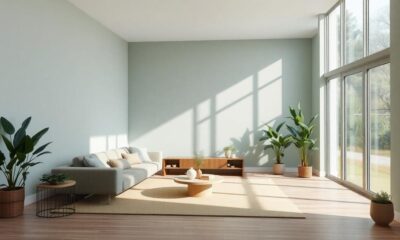Decor
Stunning Natural Elements to Incorporate in Your Home Decor – See the Amazing Results!
Journey into the world of stunning natural elements for your home decor and uncover the amazing transformations that await!

Incorporating stunning natural elements into your home decor can truly elevate your space. Use materials like wood, stone, and organic textiles to create warmth and comfort. Maximize natural light by opting for larger windows and lighter fabrics. Add houseplants to purify the air and bring a calming effect. Nature-inspired color schemes, with earthy tones and hues from the ocean or forests, can enhance tranquility. You can also include small water features for soothing sounds. With thoughtful integration of these elements, you'll foster a deep connection to nature in your home, and there's even more to discover about enhancing your decor!
Key Takeaways
- Incorporate natural materials like wood, stone, and metal to enhance warmth and texture in your home decor.
- Use houseplants to improve air quality, reduce stress, and create a calming atmosphere.
- Maximize natural light with larger windows, mirrors, and lighter fabrics to brighten your space.
- Choose nature-inspired color schemes with ocean blues, forest greens, and earthy browns for tranquility.
Why Embrace Natural Elements

Embracing natural elements in your home decor not only enhances your well-being but also creates a calming atmosphere that connects you to nature. By incorporating natural materials like wood, stone, and textiles made from wool or cotton, you'll add warmth and authenticity to your living spaces. These materials not only look beautiful but also evoke a sense of tranquility, making your home feel more inviting and harmonious.
Using organic textures and earthy tones fosters a grounded environment, enhancing both the aesthetic appeal and your overall mood. Imagine surrounding yourself with soothing colors like ocean blues and forest greens. These hues not only beautify your space but also promote feelings of serenity, allowing you to unwind and relax after a long day.
Moreover, embracing natural elements can positively impact your air quality, creating a healthier living atmosphere. The right combination of organic textures and natural materials can transform your home into a sanctuary where stress melts away, leaving you rejuvenated.
Benefits of Houseplants

Houseplants offer a myriad of benefits that can transform your living space into a healthier and more uplifting environment. One of the most notable advantages is their ability to improve indoor air quality. By filtering out toxins and pollutants, houseplants create a cleaner atmosphere that promotes overall well-being. Certain varieties, like peace lilies and spider plants, excel at absorbing harmful substances, making them excellent choices for your home.
Additionally, houseplants can greatly reduce stress and anxiety levels. Studies show that having greenery around you fosters a calming effect, helping you unwind after a long day. This natural connection to the environment not only enhances mood but also boosts productivity. Research indicates that being around indoor plants can improve concentration and creativity by up to 15%.
Moreover, caring for houseplants instills a sense of responsibility and connection to nature. This nurturing aspect can lead to greater life satisfaction and improved mental health. So, incorporating houseplants into your decor isn't just about aesthetics; it's a step toward creating a more vibrant, healthy, and joyful living space.
Maximizing Natural Light

Maximizing natural light in your home not only brightens your space but also boosts your mood and productivity. To effectively incorporate natural light into your design, start by considering larger windows, glass doors, or skylights. These features allow sunlight to fill your living areas, making them more inviting.
Another smart design tip is to strategically place mirrors around your home. Mirrors can reflect natural light into darker corners, enhancing brightness and creating the illusion of a larger space.
When it comes to window treatments, swap out heavy drapes for lighter fabrics. This simple change can greatly increase the amount of natural light entering your rooms, contributing to a more cheerful atmosphere.
Additionally, paint your walls in light colors and choose light-colored furnishings. These shades will reflect sunlight and maximize its impact, ensuring every room feels airy and bright.
Selecting Natural Materials

Selecting natural materials like wood, stone, and metal brings warmth and texture into your home, creating an inviting atmosphere that connects you with the outdoors. These elements not only enhance your home decor but also promote a sense of comfort and authenticity. By incorporating textiles made from natural fibers such as wool, linen, and cotton, you add tactile richness that makes your spaces feel cozy and grounded.
Here's a quick comparison of some popular natural materials to evaluate for your home design:
| Material | Benefits |
|---|---|
| Wood | Adds warmth, rustic charm |
| Stone | Provides durability, unique textures |
| Metal | Offers a modern touch, stability |
| Natural Fibers | Enhances coziness and tactile appeal |
Utilizing these natural materials fosters a serene environment and allows for a deeper connection to nature within your living spaces. Additionally, selecting sustainable, eco-friendly options reduces your carbon footprint and supports a healthier indoor environment. Embrace the beauty of natural materials in your home decor, and enjoy the amazing results they bring to your design!
Nature-Inspired Color Schemes

Embracing nature-inspired color schemes can transform your living spaces into serene retreats that echo the calming beauty of the outdoors.
By using hues such as ocean blues, forest greens, and earthy browns, you can create a tranquil environment that promotes relaxation and well-being. These colors help foster a serene atmosphere, making them ideal for bedrooms and areas meant for unwinding.
Incorporating these nature-inspired color schemes into your home decor enhances your design aesthetic, unifying the space and creating a cohesive look.
You can paint walls in soft greens or blues, choose furniture that reflects earthy tones, or add accessories that capture the essence of nature. This approach not only beautifies your interiors but also brings a sense of calmness, reducing stress and improving your mood.
Biophilic Design Explained
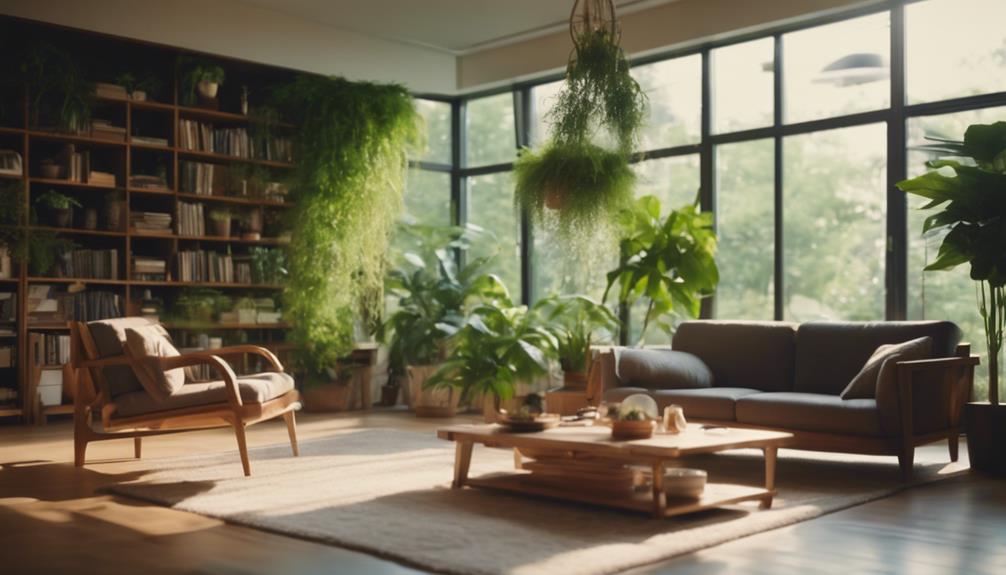
Biophilic design taps into our natural inclination to connect with the outdoors, making it a powerful approach to enhance your home environment. By integrating natural elements like plants, natural light, and organic materials, you can create indoor environments that promote well-being. This design philosophy, which gained traction in the 1970s, has become increasingly important as we seek healthier living spaces.
Research indicates that spending just two hours outdoors each week can remarkably lower stress and anxiety levels. With this in mind, incorporating biophilic design into your home helps bring the calming benefits of nature inside. Imagine how much more serene your space could feel with vibrant greenery, soft sunlight, and earthy textures. These natural elements not only improve air quality but also boost your mood and productivity.
Ultimately, biophilic design fosters a stronger connection to the natural world, enhancing your overall sense of peace and balance. As you consider ways to refresh your home decor, remember that embracing biophilic principles can transform your space into a tranquil oasis that nurtures your mind and spirit.
Practical Incorporation Ideas
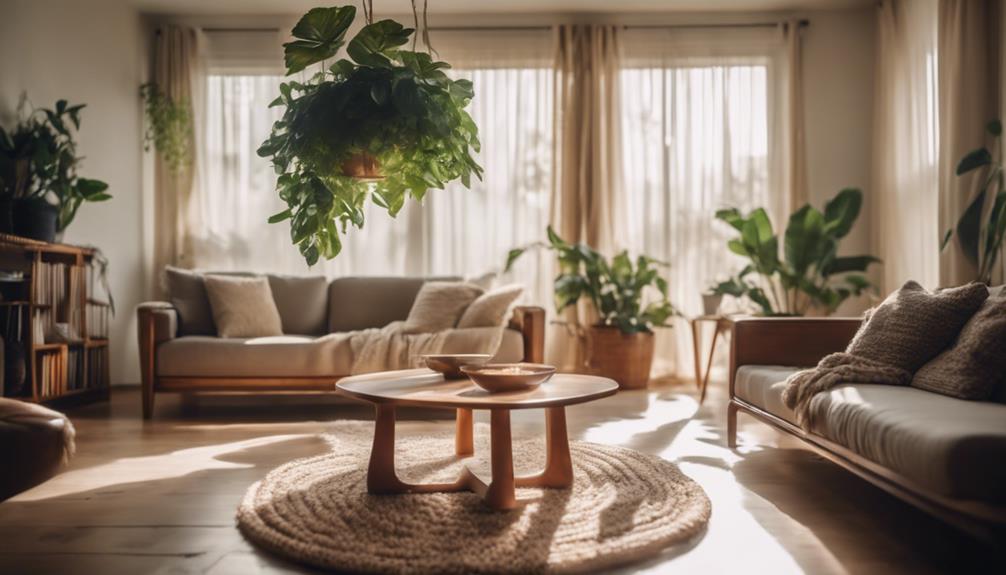
You can easily incorporate biophilic design elements into your home by adding features that connect you to nature. Start by integrating natural stone in your interior design, whether in your shower or as decorative accents. This approach creates a natural texture and visual interest, grounding your space in the beauty of the outdoors.
Next, consider adding a small water feature, like a fountain, which brings soothing sounds that enhance tranquility and create a calming atmosphere. Swapping heavy drapes for light, sheer fabrics can greatly increase natural light flow in your home, boosting your mood and reducing anxiety.
Becoming a plant parent is another great way to improve your indoor environment. Select easy-care varieties like succulents or pothos to deepen your connection to nature while enhancing your air quality.
Seasonal Design Tips
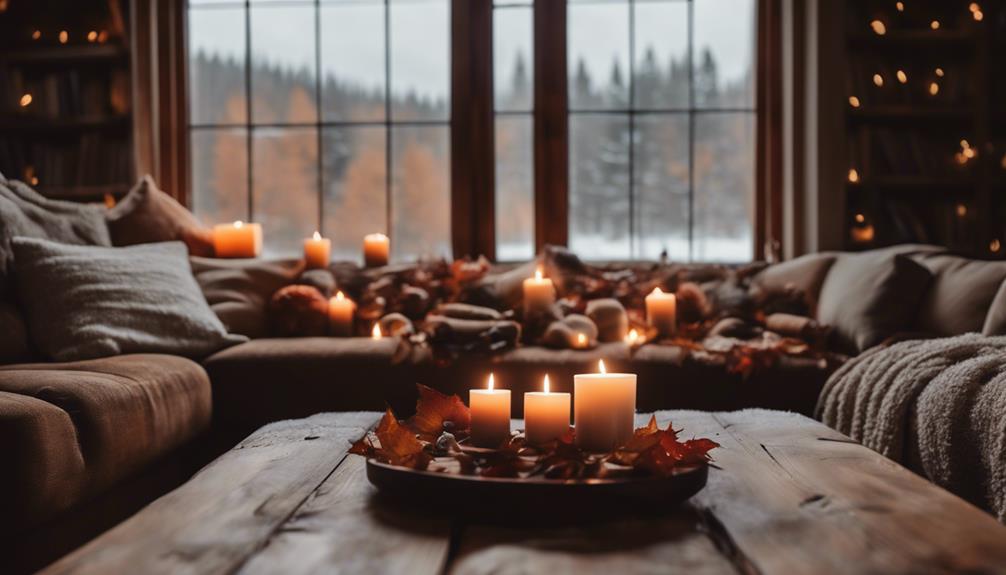
Transforming your home with seasonal design tips can breathe new life into your space and foster a deeper connection to the changing environment.
One effective approach is to replace carpeting with hardwood floors. This not only enhances the natural feel of your home but also simplifies maintenance, making it a practical choice for seasonal redesigns.
Consider incorporating nature-inspired paint colors like soft blues, greens, and yellows to evoke tranquility and reflect the seasons. These hues can seamlessly blend with your design style, creating a calming atmosphere.
Additionally, bring the outdoors in by playing nature sounds like birds chirping or water flowing, which can replicate outdoor environments and promote relaxation during seasonal changes.
Creating seamless shifts between your interior and exterior spaces is essential. Use sliding doors that open to a garden, allowing you to enjoy nature year-round.
Don't forget to open your windows during springtime to let in fresh air and natural light, rejuvenating your living space and enhancing your overall well-being.
Community Engagement in Design

Engaging with community features in design not only sparks creativity but also fosters collaboration among members enthusiastic to share their unique perspectives. By participating in design challenges, you leverage the power of community engagement, transforming your ideas into stunning visuals that resonate with others.
Here's a glimpse of how community involvement can inspire and elevate your design experience:
| Aspect | Benefit | Example |
|---|---|---|
| Design Challenges | Encourages participation and creativity | Monthly themed competitions |
| User-Generated Content | Diverse techniques and inspiration | Showcase of trending designs |
| Community Events | Learning from peers | Workshops and meet-ups |
| Timely Notifications | Keeps you informed and engaged | Alerts for upcoming challenges |
These interactions create a supportive environment where you can connect with fellow enthusiasts, explore a range of design styles, and innovate together. You'll discover that user-generated content is not just a resource; it's a source of inspiration that fuels your passion for home decor. So immerse yourself, share your ideas, and watch your creativity flourish!
Tools for Natural Decor

When you're ready to enhance your space with natural decor, having the right tools can make all the difference.
You'll find a variety of eco-friendly material options that not only beautify your home but also support sustainability.
Let's explore some essential decorating tools and materials that can help you create a harmonious natural environment.
Essential Decorating Tools
What tools do you need to elevate your natural decor? To truly bring nature indoors and create a harmonious space, having the right essential decorating tools is vital. These tools won't only help you design into your home but also guarantee that each element adds visual interest.
Here are three must-have items to get you started:
- Measuring Tape and Level: These tools guarantee your natural elements, like wood accents and plants, are placed perfectly.
- High-Quality Scissors or Pruning Shears: Keep your live plants healthy and looking their best with these essential tools.
With these essential decorating tools, you'll find it easier to decorate your home in a way that reflects your love for nature.
Plus, don't forget to document your design process with a camera or smartphone; it's a great way to track your progress and visualize how all the elements harmonize in your space.
Eco-Friendly Material Options
Eco-friendly materials like bamboo, reclaimed wood, and natural stone instantly enhance your decor while minimizing environmental impact. These materials offer unique textures and warmth, making your space feel inviting.
By choosing organic cotton and linen for your textiles, you not only boost comfort but also support sustainable farming practices, reducing chemical use in production.
Incorporating recycled glass into your decor, whether through vases or lighting fixtures, adds a modern touch while minimizing waste. This choice reflects your commitment to sustainability without compromising on style.
When it comes to wood treatments, opt for natural finishes like beeswax or plant-based oils. These non-toxic options preserve the beauty of wood and promote healthier indoor air quality.
Frequently Asked Questions
What Are Natural Materials to Decorate?
You can decorate with natural materials like wood, stone, and metals for warmth. Incorporate textiles from cotton and linen, and consider rattan or wicker for rustic charm. Sustainable options like reclaimed wood add unique character to your space.
How Do You Bring Nature Into Your Home Decor?
Did you know that incorporating natural elements can reduce stress by 60%? To bring nature into your home decor, add houseplants, use earthy colors, and utilize natural materials for a calming, vibrant atmosphere.
What Are the Elements of Good Interior Design?
Good interior design balances functionality and aesthetics. You should maximize natural light, incorporate diverse textures, choose a cohesive color palette, and arrange furniture thoughtfully to create inviting spaces that foster positive interactions and enhance everyday living.
Why Is Nature Important in Interior Design?
Imagine sunlight streaming through large windows, illuminating lush green plants. Nature's essential in interior design because it boosts your mood, purifies air, and creates serene spaces, making your home a healthier, more inviting retreat.
Can DIY Projects Incorporate Stunning Natural Elements in Home Decor?
Looking to give your home a fresh new look? Consider incorporating stunning natural elements into your diy home spruce up project. Embrace the beauty of nature by adding elements like wood, plants, or stone to your decor. DIY projects can easily enhance your space with these natural touches.
Conclusion
Incorporating stunning natural elements into your home decor can transform your space into a serene oasis that feels like a five-star retreat!
By embracing houseplants, maximizing natural light, and choosing organic materials, you'll create an inviting atmosphere that not only looks amazing but also boosts your well-being.
So go ahead, release your creativity and let nature's beauty shine in your home.
You'll be amazed at the incredible transformation that awaits!
Decor
The Feng Shui Color Scheme That Will Make Your Home Feel Complete!
Step into a world where colors harmonize your home, creating balance and well-being—discover the secrets that await within!
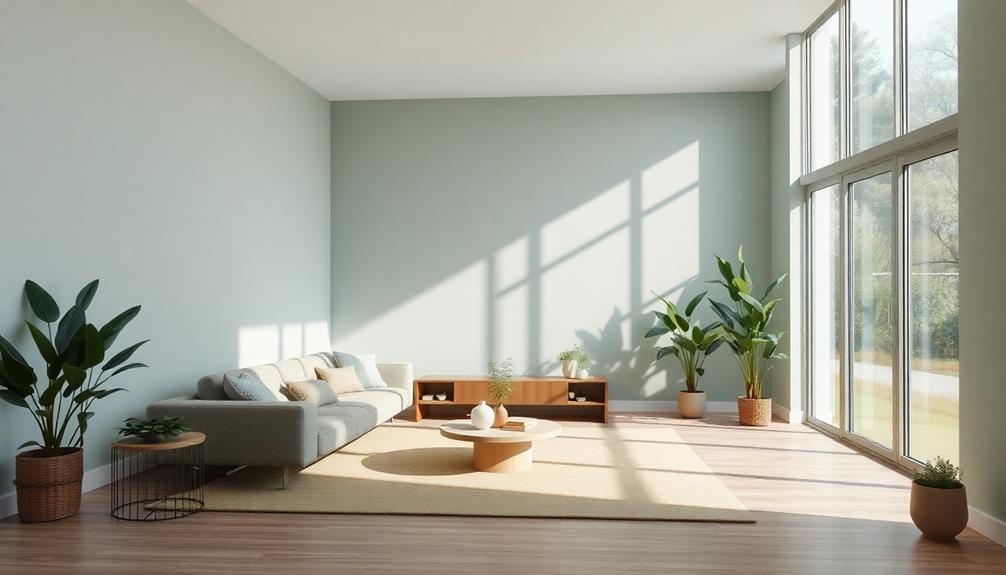
To create a complete and harmonious home using Feng Shui, focus on a balanced color scheme. Start with grounding earth tones like brown and yellow for stability. Introduce calming blues and greens for relaxation and growth. Use whites and metallics for clarity and a modern touch. Consider your emotional responses to colors, choosing hues that resonate personally. In specific rooms, opt for warm tones in kitchens and serene colors in bedrooms. This thoughtful approach not only enhances your environment but also fosters well-being. You'll discover even more effective color combinations and room-specific tips that can transform your space beautifully.
Key Takeaways
- Incorporate earth tones like brown and yellow for grounding and stability, enhancing comfort in your home.
- Use warm colors in living spaces to evoke happiness and promote social interactions, creating an inviting atmosphere.
- Balance vibrant colors with neutral tones to achieve emotional equilibrium and visual harmony throughout your home.
- Integrate nature-inspired shades like greens and soft blues to foster relaxation and a connection to the outdoors.
- Personalize your color choices based on emotional responses and cultural elements to create a space that truly resonates with you.
Understanding Feng Shui Colors
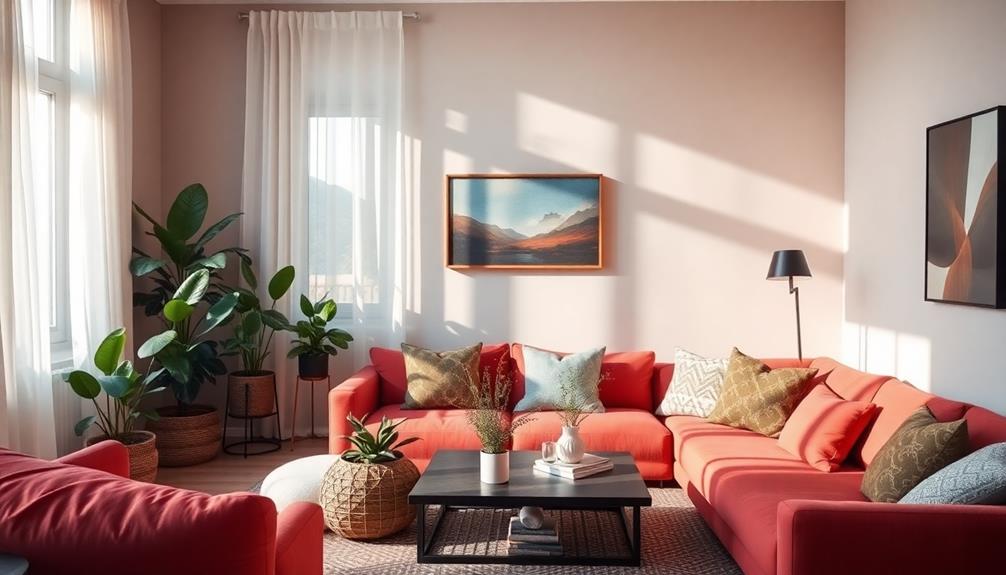
When you plunge into the world of Feng Shui colors, you'll discover that each hue carries its own energy, deeply rooted in the five elements: earth, metal, water, wood, and fire.
Understanding these feng shui colors can transform the atmosphere of the spaces in your home. For instance, incorporating Indonesian decorative pillows with vibrant colors and intricate patterns can enhance the cozy vibe created by earth tones.
Earth colors, like brown and yellow, ground you, fostering stability and creating a cozy vibe. Metal colors, including whites and metallics, enhance clarity and organization, reflecting light and contributing to a modern aesthetic.
Water colors such as black and deep charcoal gray create an environment that encourages wisdom and social connections.
Incorporating wood colors like green and teal promotes growth and liveliness, making your home feel alive.
Emotional Impact of Color

Color has a profound emotional impact on our daily lives, shaping how we feel in our spaces. The right colors can make you feel good, boost your mood, and even enhance your mental clarity. From a feng shui perspective, selecting colors that resonate with positive emotions is essential for creating a harmonious environment.
Here's a quick reference to understand the emotional impact of different colors:
| Color | Emotional Response | Feng Shui Effect |
|---|---|---|
| Warm Colors | Happiness, energy, comfort | Stimulates creativity and warmth |
| Cool Colors | Calmness, relaxation | Promotes tranquility and focus |
| Neutral Colors | Balance, comfort, and stability | Creates a soothing, inviting space |
Keep in mind that individual reactions to colors can vary based on personal experiences. A hue that brings joy to one person might evoke negative feelings in another. By carefully considering the colors in your home, you can create a space that not only looks great but also supports your emotional well-being, making every day a little brighter.
Nature-Inspired Color Choices

When you choose nature-inspired colors like soothing greens and earthy tones, you create a calming atmosphere in your home.
These colors not only enhance your well-being but also boost your mood, making your space feel more vibrant.
Incorporating elements of Balinese design characteristics can further enrich this environment, bringing authenticity and warmth to your decor.
Balancing these hues with natural elements can enrich your environment, bringing authenticity and warmth to your decor.
Soothing Natural Hues
Often, incorporating soothing natural hues like greens, browns, and soft blues can transform your home into a serene sanctuary. These natural colors create an environment that promotes emotional well-being and relaxation, much like the harmony found in traditional Indonesian style home decor.
Studies show that exposure to these colors enhances your mood and even triggers the release of endorphins, contributing to a more positive atmosphere in your space.
When you choose earth tones and muted shades, you evoke feelings of comfort and grounding, making your living area feel more inviting. A balanced color scheme drawn from nature not only enhances the aesthetic appeal of your rooms but also fosters mental clarity and peace.
By utilizing these soothing hues, you establish a calming ambiance that encourages relaxation and rejuvenation.
To create this serene environment, consider pairing soft blues with earthy browns or lush greens. This combination can help you feel more connected to the outdoors, allowing you to escape the stresses of daily life.
Ultimately, when you embrace soothing natural hues, you invite tranquility into your home, making it a complete and nurturing space for you and your loved ones.
Plants and Color Benefits
Integrating plants into your home not only enhances its beauty but also brings the calming power of nature indoors. By incorporating natural colors inspired by plants—like various greens and browns—you create a soothing environment that promotes well-being and comfort. These colors, combined with the presence of plants, can greatly improve your mood, fostering a positive atmosphere.
Using plant colors in your decor connects your indoor space to nature, creating a sense of liveliness and balance. When you allow natural light to flood in, it highlights these colors and plants, amplifying their benefits. A balanced color scheme featuring hues found in nature aids in creating a serene atmosphere, essential for mental clarity and relaxation.
Here's a quick reference to help you understand the benefits of different plant colors:
| Color | Benefit | Suggested Plants |
|---|---|---|
| Green | Promotes calmness | Snake Plant, Ferns |
| Brown | Grounding and stability | Pothos, Rubber Plant |
| Yellow | Boosts happiness | Sunflowers, Marigolds |
| White | Enhances clarity | Peace Lily, Orchids |
Incorporating these elements will transform your space into a sanctuary.
Balance With Earth Tones
Creating a harmonious living space means considering the power of earth tones in your color scheme. These nature-inspired colors—browns, yellows, and warm earthy shades—create a cozy, inviting atmosphere that enhances feelings of stability and comfort. Incorporating earth tones in your home fosters a strong connection with the outdoors, promoting tranquility and well-being.
Additionally, traditional Indonesian housing, known as Rumah Adat, often utilizes local materials that reflect the natural environment, further emphasizing the importance of nature in design.
When you utilize these colors, you help ground the energy in your space, supporting overall emotional balance and harmony. Earth tones are known to evoke positive emotions and can greatly reduce anxiety, making them ideal for relaxation areas like living rooms and bedrooms.
Mixing various earth tones in your decor not only creates a visually appealing environment but also resonates with the principles of feng shui. This approach leads to enhanced mental clarity and health, allowing you to feel more centered and at peace.
To achieve the perfect balance, consider using a palette of earth tones to transform your home into a sanctuary. By doing so, you invite a soothing energy that nurtures your spirit and fosters a sense of belonging.
Embrace the tranquility that comes with these beautiful, nature-inspired colors!
Guidelines for Effective Color Selection
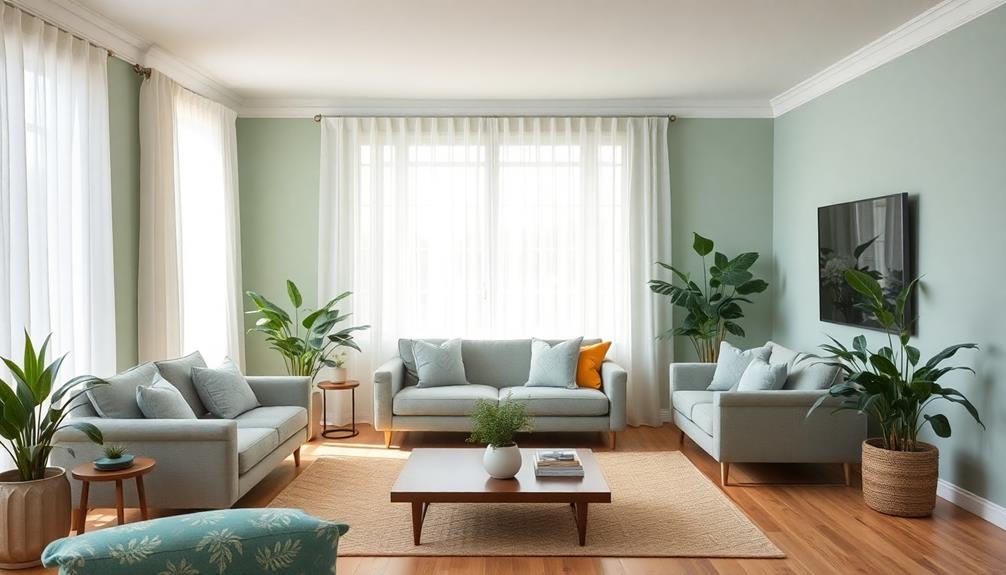
When selecting colors for your home, consider how different shades evoke emotional responses and align with your personal preferences.
Incorporating elements like traditional artistry can enhance the aesthetic appeal of your space.
Nature-inspired colors can enhance your space, creating a calming atmosphere that resonates with you.
Keep these factors in mind to craft a cohesive and inviting environment that feels just right.
Emotional Color Responses
Understanding emotional color responses is essential for selecting the right hues for your home. Your individual reactions to colors can differ markedly based on personal experiences, so it's important to choose shades that evoke positive emotions.
For instance, neutral colors are perfect for connecting rooms and hallways, as they promote a seamless shift while maintaining a calming atmosphere. Incorporating unique art pieces, such as an Indonesian decor mask, can also enhance the emotional ambiance of your space, as they represent rich cultural heritage and craftsmanship.
In spaces like bedrooms and bathrooms, warm tones such as soft peaches and pinks create a soothing environment, fostering tranquility and restful sleep. However, be cautious about incorporating bright yellow, as it's linked with irritation and can disrupt the positive energy flow in your home.
To enhance your overall well-being, think about integrating natural colors and images. Studies show that exposure to nature can positively influence mood and reduce stress, making your home a sanctuary.
By carefully considering your emotional color responses, you can create a harmonious space that promotes comfort and happiness. Remember, the right colors can substantially impact your mood and energy, making it imperative to reflect on how each hue resonates with you personally.
Choose wisely, and your home will feel complete.
Nature-Inspired Color Choices
Nature-inspired color choices can considerably enhance the tranquility of your home. By incorporating shades of greens and browns, you can create a soothing environment that promotes well-being and comfort. These colors evoke the serenity found in nature, allowing you to feel more relaxed in your space.
For example, in tropical villa plans, emphasizing outdoor living areas with natural color palettes can further amplify this connection to nature.
When selecting colors for connecting rooms and hallways, consider using neutral colors. They create a seamless flow throughout your home, helping to maintain a cohesive look.
For bedrooms and bathrooms, warm tones foster a sense of calm, making these spaces feel inviting and peaceful.
It's best to avoid bright yellow in your decor, as it can create feelings of irritation. Instead, choose colors that evoke emotional positivity and personal comfort.
Utilizing plant colors and natural materials in your color scheme not only enhances aesthetic appeal but also cultivates a serene atmosphere that aligns with feng shui principles.
Balancing colors inspired by nature aids in creating a visually appealing space while supporting your emotional well-being.
Personal Preference Importance
Although many guidelines exist for color selection in home decor, your personal preferences should always take center stage. The personal preference importance in creating a harmonious environment can't be overstated.
Your emotional response to colors plays a significant role in shaping your space, ensuring it resonates with your experiences. Additionally, incorporating unique cultural elements, such as Indonesian decor masks, can further enhance the emotional connection you have with your home.
To effectively select your color scheme, consider these guidelines:
- Reflect on Favorites: Look to your favorite clothing, artwork, or other existing color elements in your home for inspiration.
- Choose Neutral Bases: Use neutral tones for connecting rooms and hallways to promote seamless shifts.
- Add Vibrant Accents: Inject personality with vibrant accent colors that elevate your emotional experience.
- Assess Emotional Reactions: Pay attention to how specific colors make you feel, avoiding those that evoke negative emotions.
Color and Spatial Perception

Color plays an essential role in shaping how you perceive space within your home. Lighter colors can visually expand a room, making it feel larger and more open. If you want to create a sense of spaciousness, consider painting your walls in softer shades.
Additionally, the principles of modern tropical aesthetics often emphasize the integration of natural materials and colors that resonate with the surrounding environment, further enhancing the feeling of openness. Darker hues, on the other hand, tend to create a more confined and intimate atmosphere, which might work well in cozy areas like bedrooms.
Choosing ceiling colors that are lighter than your walls is another trick to enhance the perception of height and space. This simple adjustment can considerably impact how you feel in that room.
When it comes to connecting rooms and hallways, using neutral colors promotes a seamless flow, contributing to overall harmony in your home.
In spaces like kitchens, incorporating warm and earth tones fosters a welcoming environment, encouraging nourishment and comfort during meal preparation.
Personal Preference in Color Selection

When it comes to choosing colors for your home, personal preferences should take center stage. The colors you select not only influence your emotional responses but also impact your overall satisfaction with the space.
To create a vibrant and unique atmosphere, you might also consider incorporating elements inspired by cultural designs, such as Indonesian wedding decor ideas, which can add depth and character to your home.
Here are some tips to help you create a cohesive color scheme that resonates with you:
- Draw Inspiration: Look at your favorite clothing, artwork, or existing decor to find colors that speak to you.
- Utilize Existing Items: Incorporate colors from rugs or paintings to unify the room and deepen your emotional connection.
- Consider Personal Experiences: Remember that everyone reacts differently to colors. Choose hues that evoke positive feelings for you and your family.
- Aim for Well-Being: The ultimate goal is to create an environment that feels good and promotes your well-being.
Room-Specific Color Recommendations
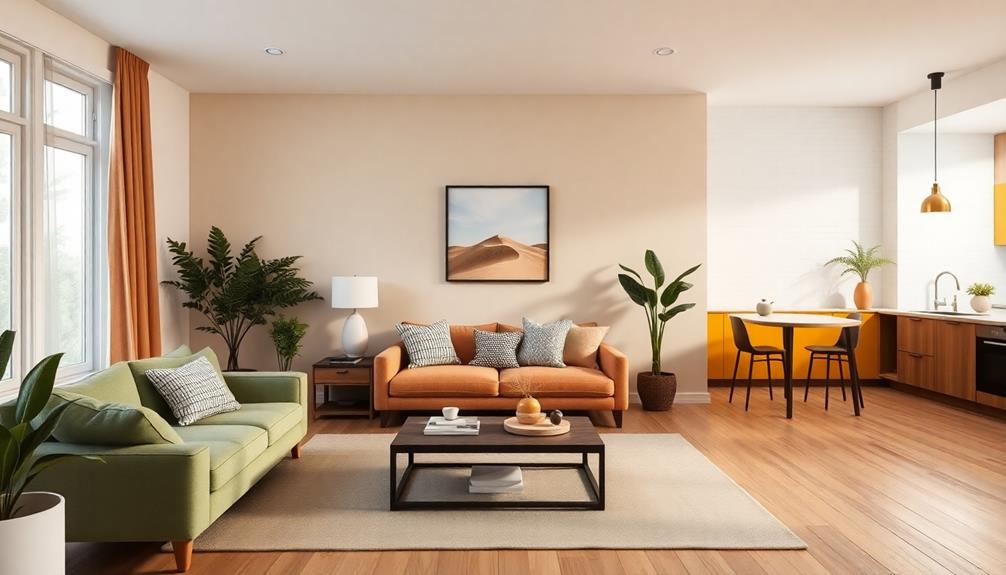
Choosing the right colors for each room can transform the energy and mood of your home. For entryways, welcoming colors like red, green, or black can enhance positive energy flow, making your guests feel warm and invited.
In living rooms, consider bright blues and greens; these colors attract good feng shui and promote social interactions. Pairing these shades with nature-themed decor can further enhance the harmonious atmosphere.
Kitchens should embrace warm earth tones and whites to emphasize nourishment, creating an inviting space for meal preparation and gathering.
When it comes to bedrooms, soft peach and pink hues foster romance and love, while restorative greens can enhance liveliness and rejuvenation, ensuring a restful retreat.
In hallways, opt for neutral colors to connect spaces seamlessly. This simplicity creates a calming effect and encourages smooth changes between rooms.
Incorporating broad-leaf plants can also signify a thriving environment, enhancing the overall energy flow.
Practical Tips for Color Mixing

To create a harmonious atmosphere in your home, mixing colors thoughtfully can make all the difference. Each color you choose contributes unique emotional and energetic qualities based on feng shui principles.
Here are some practical tips for effective color combinations:
- Warm Hues: Incorporate salmon in living areas for a warm, inviting energy. This blend of yellow/orange and red/orange fosters a sense of comfort and connection.
- Calming Shades: Use turquoise in restorative spaces. It combines qualities of both wood and water, promoting growth and tranquility—perfect for a serene environment.
- Tranquil Tones: Consider lavender for bedrooms or relaxation areas. This mix of blue and purple encourages calmness, transforming your space into a peaceful retreat.
- Balanced Palette: Combine neutral tones with vibrant colors to maintain balance. This approach not only enhances aesthetic appeal but also influences mood and behavior, creating a space that feels both alive and restful.
Frequently Asked Questions
What Is the Best Color for a House in Feng Shui?
In feng shui, the best color for your house depends on desired energy. Warm earthy tones create stability, while vibrant colors at the front door invite opportunities. Choose neutrals for flow and soft hues for calming spaces.
What Color Makes You Feel at Home?
Studies show that 90% of people feel more relaxed in green spaces. You'll likely feel at home with soothing greens or warm neutrals, as they create a comforting environment that resonates with your personal preferences.
What Is the Color of Success in Feng Shui?
In feng shui, colors like purple, green, and gold symbolize success. Incorporate these shades into your space to attract wealth and prosperity. Red energizes your goals, while metallics enhance clarity and achievement. Choose wisely!
What Are the Calming Colors for Feng Shui?
Imagine a tranquil forest where soft blues and greens whisper serenity. You'll find that calming colors like light yellows and gentle earth tones can transform your space, fostering balance and inviting tranquility into your life.
Conclusion
By embracing the right feng shui color scheme, you create a harmonious space that nourishes your soul. Think of your home as a canvas; just as an artist carefully selects colors to evoke emotion, you can use hues to shape your environment. Imagine walking into a room painted in soft greens and blues, instantly feeling a wave of calm wash over you. So, trust your instincts, blend wisely, and watch your home transform into a sanctuary that truly reflects you.
Decor
How to Use Feng Shui to Create a Balanced and Inviting Living Space
Optimize your living space with Feng Shui principles for balance and harmony; discover the essential tips to transform your home into a soothing sanctuary.
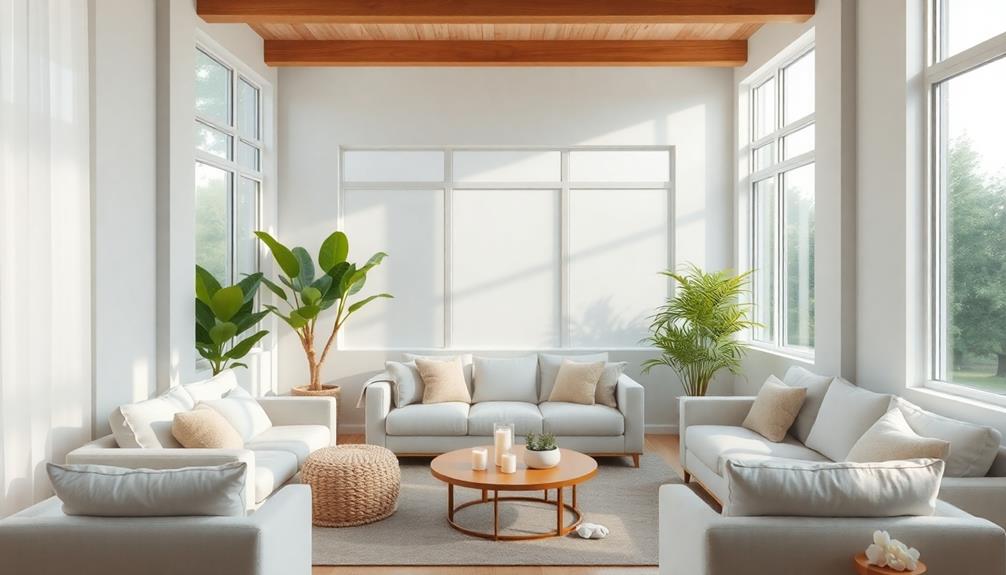
You can create a balanced and inviting living space using key Feng Shui principles. Start by positioning your furniture in a commanding position, allowing clear views of entrances. Keep pathways clear to enhance energy flow and declutter regularly to avoid stagnation. Incorporate natural materials and soothing colors that reflect the five elements for harmony. In your entryway, make certain it's clutter-free and well-lit to create a welcoming atmosphere. Remember, each room has unique energy needs. Explore how to optimize every area of your home for ultimate balance and comfort.
Key Takeaways
- Arrange furniture in a commanding position to enhance security and promote a sense of control in your living space.
- Keep entryways and pathways clear to allow smooth energy flow and create a welcoming atmosphere.
- Incorporate natural materials and earth tones to foster a calming environment and promote positive energy.
- Regularly declutter your space to prevent stagnant energy and maintain a vibrant, inviting atmosphere.
- Utilize the Bagua Map to align colors and elements with specific life areas for enhanced balance and harmony.
Understanding Feng Shui Principles
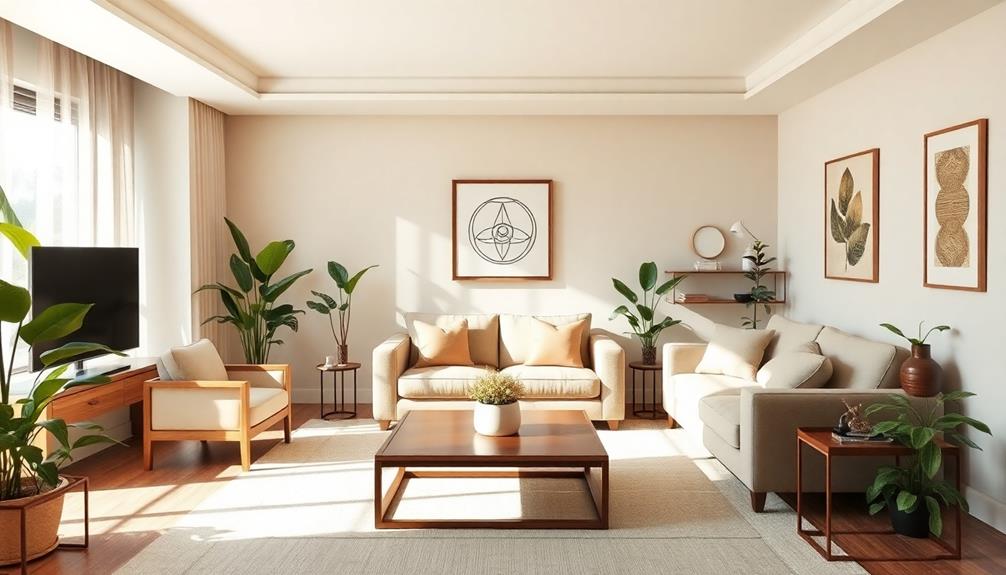
To get a grasp on Feng Shui principles, you need to focus on the flow of chi, or essential energy, that shapes your living space. This flow is essential for creating harmony and balance, so start by evaluating how your furniture is arranged.
Positioning your furniture in a commanding position allows you to see the entrance, fostering a sense of security and control. Consider incorporating natural materials and earth tones in your decor to enhance the calming effects and align with Balinese design characteristics.
Next, utilize the Bagua Map to identify areas of your life that can be enhanced by aligning colors and elements with specific zones in your home. Incorporating the five elements—fire, wood, earth, metal, and water—into your decor not only balances energies but also promotes overall well-being.
Additionally, regular decluttering is essential in Feng Shui. It prevents stagnant energy and guarantees a clear pathway for positive energy flow throughout your space.
Optimizing Your Entryway
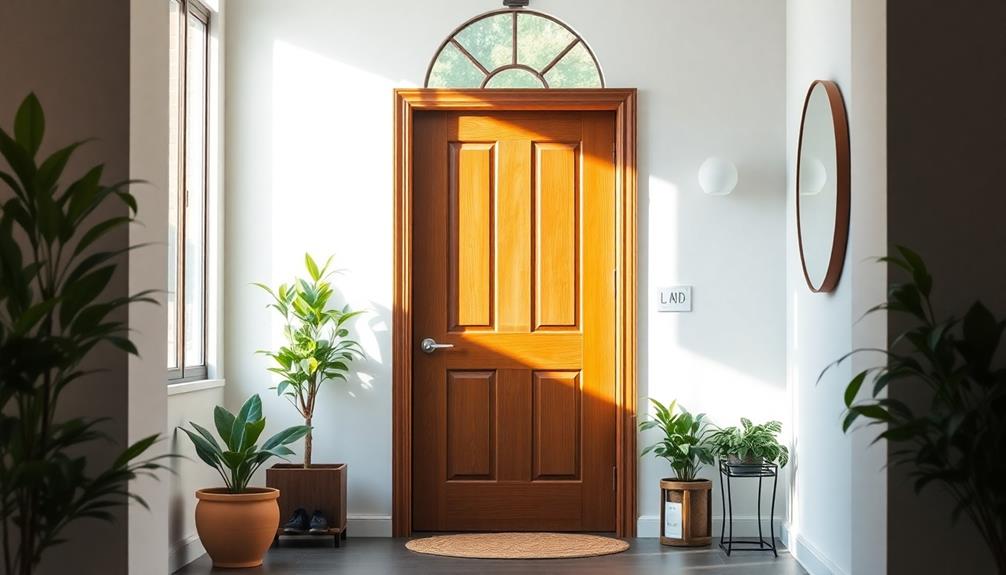
How can you create an inviting and energetic entryway that welcomes positive chi into your home?
Start by keeping your entryway clutter-free. This space, often referred to as the "mouth of qi," needs to allow positive energy to flow smoothly. Make sure you have clear pathways leading into your home, which helps energy move freely without obstruction.
To enhance the aesthetic appeal, consider incorporating traditional artistry like Indonesian decor masks that reflect cultural heritage and invite vibrant energy.
Bright lighting is crucial, as it enhances the welcoming energy, creating a friendly atmosphere for everyone who enters. Consider adding a functioning doorbell; it symbolizes your readiness for new opportunities and positive interactions.
Incorporate elements that reflect the five elements of feng shui—wood, fire, earth, metal, and water. You can use plants to represent wood and water features to symbolize the flow of energy.
Decorative items like candles or crystals can represent fire and earth, bringing balance and liveliness to your entryway.
Designing a Harmonious Living Room
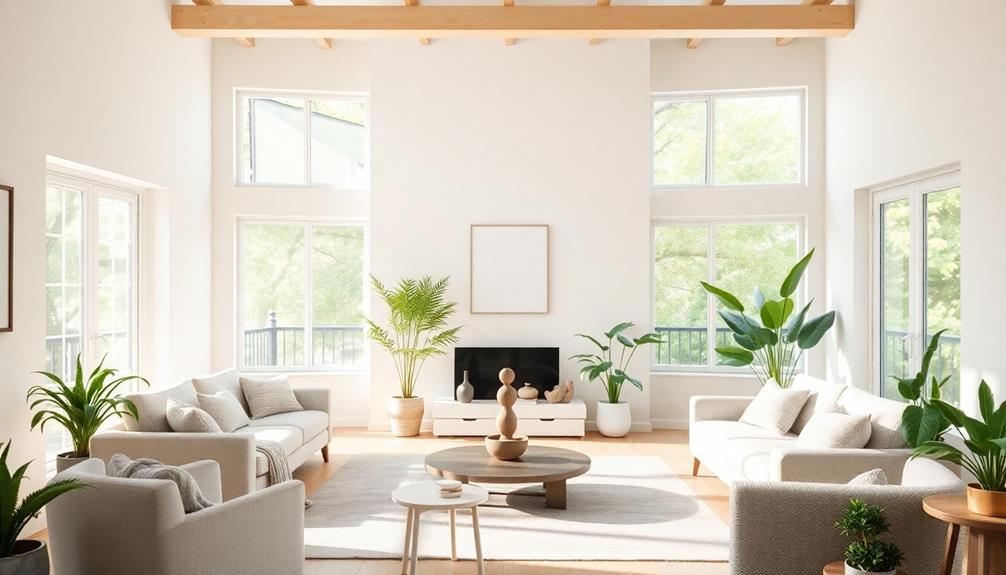
After creating a welcoming entryway, the next step is to focus on designing a harmonious living room that promotes relaxation and connection. Start by arranging your seating in a commanding position, allowing everyone to have clear views of the entrance. This setup fosters a sense of security and comfort.
Consider adding Indonesian decorative pillows with vibrant colors and intricate patterns to enhance the comfort of your seating while reflecting cultural heritage.
Incorporate the five elements into your design using color choices and decor. Opt for wood furniture to inspire creativity and add fire accents like candles to ignite passion. Ascertain that the flow of energy, or chi, remains unobstructed by maintaining clear pathways and avoiding the blocking of doorways with furniture.
Integrate plants and natural materials to enhance air quality and bring vibrancy into the space. This connection to nature fosters liveliness and a calming atmosphere.
Don't forget to regularly declutter surfaces and organize your decor, as this helps maintain a serene environment, preventing stagnant energy and encouraging positive interactions among occupants.
Creating a Welcoming Dining Space

A welcoming dining space is essential for fostering connections and creating memorable experiences with family and friends. To achieve this, focus on creating a balanced dining setting that encourages conversation and enjoyment. Here are key elements to reflect on:
| Element | Description |
|---|---|
| Clear Table | Keep your dining table free of clutter before meals to enhance focus and the shared experience. |
| Fresh Flowers | Incorporate fresh flowers to invite positive energy and promote harmonious relationships among guests. |
| Table Positioning | Position the dining table so that all diners can see each other comfortably, facilitating connection. |
When setting the table, reflect the five elements of Feng Shui through your place settings and decor. This not only enhances the overall energy of the space but also creates a visually appealing atmosphere. Regularly using your dining area fosters community, making it a place where connections can grow. By incorporating these elements, you'll create a welcoming dining space that radiates warmth and positivity, ensuring that every meal becomes an opportunity for meaningful interaction.
Enhancing Kitchen Energy
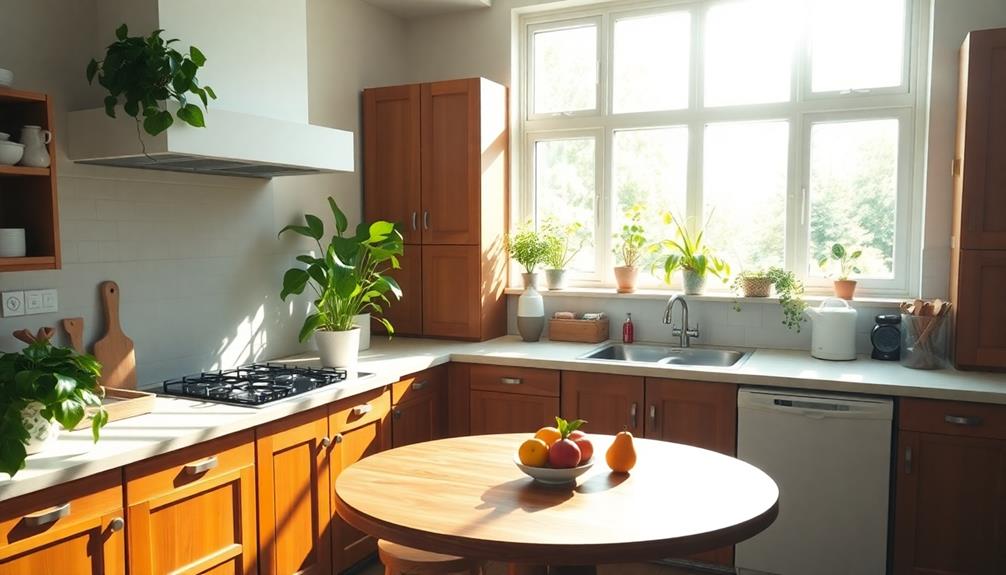
To enhance the energy in your kitchen, start by keeping your stove clean and in regular use, as it represents prosperity.
Incorporating natural materials, like wood and stone, can also contribute to a balanced environment while reflecting a connection to nature, similar to Traditional Indonesian Style Home Decor.
Make sure to dispose of any expired food and clutter to maintain fresh and vibrant energy.
Clean and Organize Stove
Cleaning and organizing your stove is crucial for boosting the energy in your kitchen. A stove clean and well-maintained symbolizes prosperity and abundance, key elements in creating a positive energy flow. Make it a habit to wipe down your stove regularly, ensuring it's not just functional but also a focal point of your kitchen.
Consider incorporating vibrant colors and patterns in your kitchen decor to enhance the inviting atmosphere, much like the Indonesian wedding decor that celebrates cultural richness.
To enhance this inviting atmosphere, organize your pots, pans, and cooking utensils. When everything has its place, you'll find cooking becomes easier and more enjoyable. A clutter-free environment fosters a sense of calm and efficiency, making meal preparation a pleasure rather than a chore.
Additionally, try to utilize your stove daily. This not only activates the energy associated with abundance but also keeps your kitchen vibrant and alive. Remember, the energy in your kitchen starts with the stove; it's where nourishment is created.
Lastly, let natural light flood your kitchen space. This enhances liveliness and promotes a warm, inviting ambiance, encouraging gatherings and joyful cooking experiences.
With these simple steps, you'll cultivate a kitchen that radiates positive energy and abundance.
Fresh Food Disposal
Expired food lurking in your fridge can sap the positive energy from your kitchen, creating stagnant chi that affects your overall well-being. To counteract this, practice fresh food disposal regularly.
Making space for decor elements like Indonesian decor masks can also enhance the cultural energy in your kitchen, adding a unique aesthetic that promotes positive vibes.
Make it a habit to check your refrigerator and pantry for expired or spoiled items, and dispose of them promptly. This small action can greatly enhance the flow of energy in your space.
Keep your refrigerator organized and clutter-free to maintain an inviting atmosphere that promotes healthy eating habits.
Consider implementing a composting system for food scraps; it not only contributes to sustainability but also helps cultivate positive energy within your kitchen.
Using clear storage containers for pantry items boosts visibility and accessibility, fostering a sense of order and balance.
Schedule regular clean-outs for both your pantry and refrigerator, reinforcing your commitment to freshness and abundance in your kitchen.
This aligns seamlessly with the principles of feng shui, ensuring your space reflects harmony and liveliness.
Maximize Natural Light
A clutter-free kitchen not only boosts energy but also sets the stage for maximizing natural light. Incorporating large windows or glass doors allows ample natural light to flow in, enhancing the liveliness of your space and promoting a positive atmosphere for cooking and gatherings.
Consider incorporating elements of luxury tropical design by using natural materials that reflect the beauty of Bali, which can create a serene and inviting environment. Position your sink or cooking area near a window to enjoy the uplifting effects of natural light, which can spark creativity during meal preparation.
To maintain privacy while still inviting light, use sheer window treatments that create a bright yet welcoming ambiance. Selecting light-colored cabinetry and countertops can further reflect natural light, making your kitchen feel larger and more inviting.
The addition of vibrant colors in decor can energize the space, too.
Don't forget to clean your windows regularly to guarantee you have a clear view, as bright spaces are crucial for maintaining high levels of positive chi.
Balancing Bedroom Atmosphere
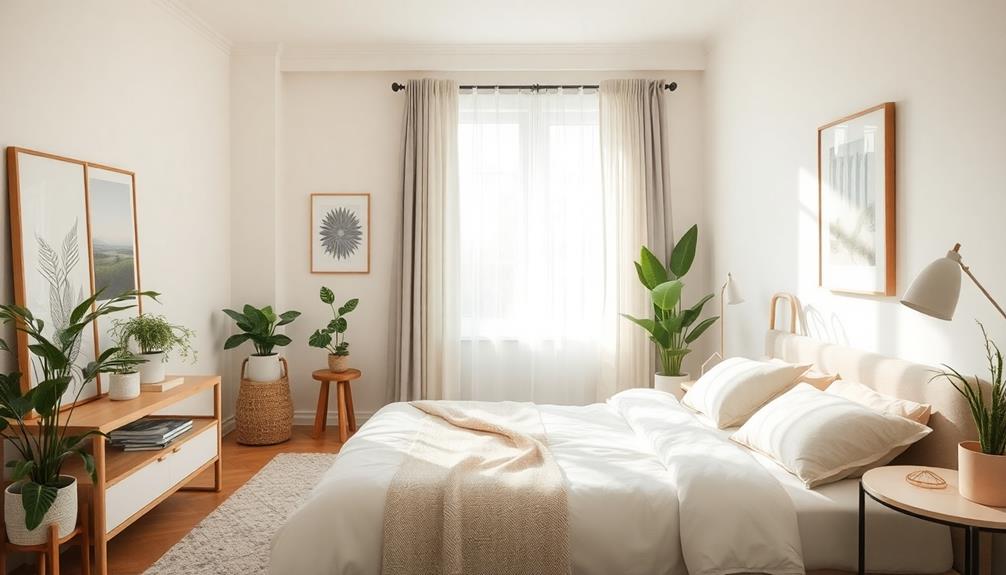
Creating a balanced bedroom atmosphere is essential for promoting restful sleep and relaxation. Start by positioning your bed in a command position, allowing you to see the door without being directly in line with it. This setup helps to cultivate a sense of security and restful energy.
To enhance stability, choose a solid wood headboard; it adds grounding support to your space. Incorporating elements of nature, such as plants or natural materials, can further enhance the calming ambiance, reminiscent of the traditional Indonesian housing that utilizes local materials for a serene environment.
Minimize distractions by keeping electronics out of the bedroom. This practice helps to eliminate negative energy and creates a tranquil environment conducive to sleep.
Incorporating nightstands on both sides of the bed is another way to create balance, ensuring that both you and your partner have equal space and comfort.
Maintain a simple decor style to facilitate positive chi movement. Clutter and excessive decor can stagnate energy and add stress, making it harder to unwind. Instead, opt for a clean, serene aesthetic that promotes calmness.
Arranging Home Office for Success
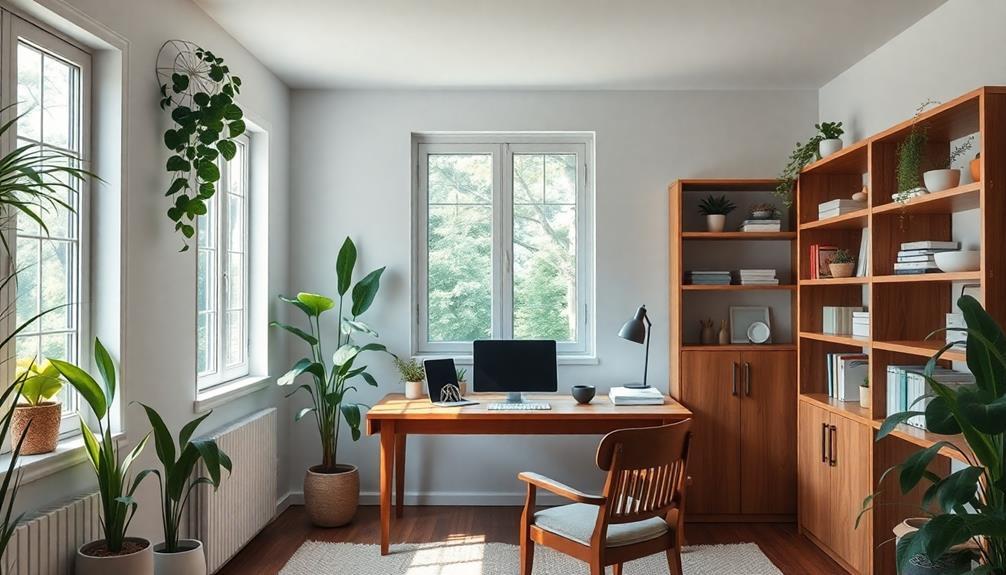
To set yourself up for success in your home office, position your desk in a commanding spot where you can see the entrance without being directly aligned with it.
This arrangement not only boosts your sense of control but also enhances focus, much like the emphasis on open floor plans in modern tropical aesthetics in Bali that promote airflow and natural light.
Pair this with regular decluttering to keep your workspace clear, allowing for a more productive and creative environment.
Commanding Position Importance
Positioning your desk in the commanding position is vital for a successful home office. This means placing your desk where you can see the entrance without being directly in line with the door. This setup fosters a sense of security and control over your environment, allowing the flow of chi to circulate freely. Supporting your back with a solid wall or a tall bookshelf adds stability and protection as you work.
Additionally, incorporating tropical villa plans can enhance your workspace by promoting open spaces and natural light, creating a serene environment conducive to productivity.
Avoid placing your desk directly in front of a window, as this can create distractions and disrupt the energy flow. Instead, aim for a side view of the window, allowing natural light to enhance your space without overwhelming you. It's also important to keep your workspace organized and clutter-free, as disorganization can lead to stagnant chi and decreased focus.
Make sure there's enough space to move around your desk comfortably. This openness promotes a positive atmosphere and encourages creativity.
Decluttering for Clarity
A cluttered workspace can stifle creativity and focus, making it difficult to achieve your goals. To enhance your productivity, start with decluttering for clarity. Regularly assess and remove unnecessary items from your home office. This practice maintains a clutter-free environment, allowing chi to flow freely and creating harmony in your space.
Organize your office supplies in labeled containers and use drawer organizers to keep your surfaces clear. This promotes a serene workspace that fosters both creativity and efficiency.
Keep in mind the significance of your desk's position; place it in the commanding position, facing the doorway without being directly in line with it. This setup creates a sense of security and control over your environment.
Incorporating natural elements, like plants or wooden decor, can bring energy and balance to your office while reducing stress.
Tips for a Serene Bathroom
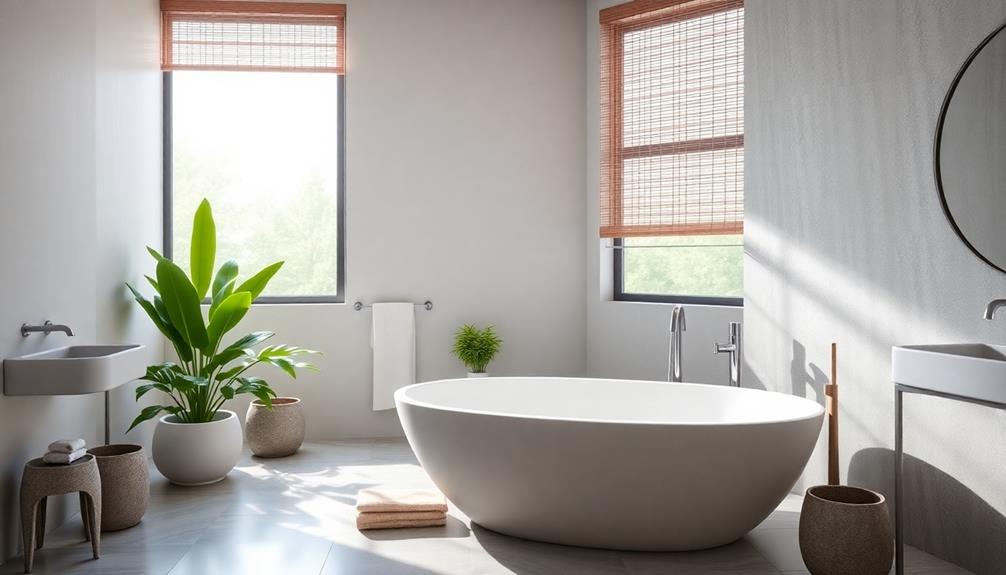
Creating a serene bathroom can greatly enhance your overall well-being. To foster a calming environment, start by clearing surfaces of clutter. This promotes the flow of chi, allowing you to enjoy a tranquil experience.
Incorporate soft, natural lighting; consider using candles or dimmable lights for added relaxation. Choose soothing colors like soft blues or greens to evoke peace and tranquility, aligning with the water element for emotional balance.
Adding plants or natural elements like stones brings in the wood and earth elements, grounding the space and enhancing liveliness. Make sure all fixtures and decor are in good repair, as broken items can disrupt energy flow and create unrest.
Here's a quick reference table to help you create your serene bathroom:
| Element | Tip | Purpose |
|---|---|---|
| Clutter | Keep surfaces clear | Promotes tranquility |
| Lighting | Use soft, natural light | Creates a calming environment |
| Decor | Incorporate plants | Fosters peace and liveliness |
General Feng Shui Practices
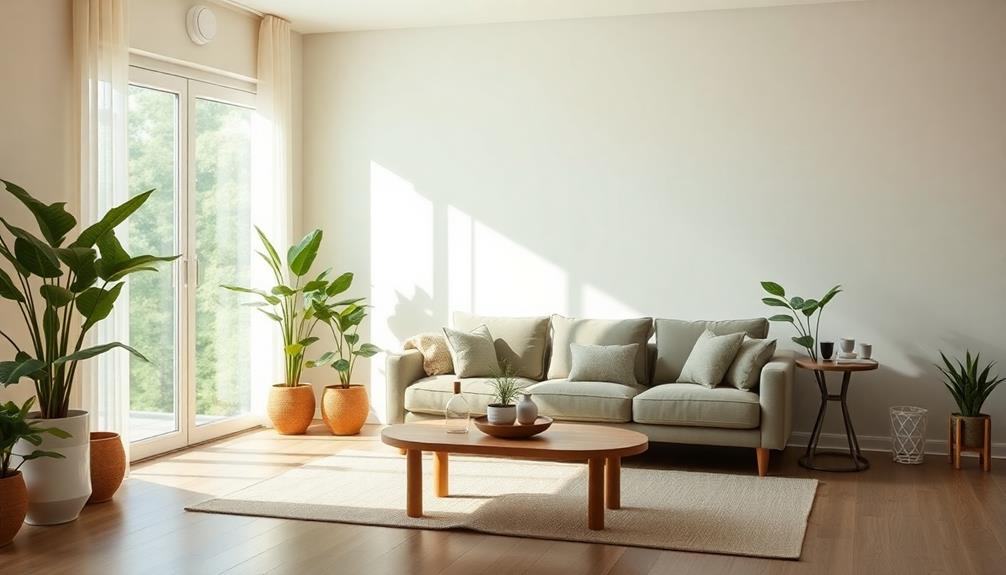
After establishing a serene bathroom, it's essential to expand those calming principles throughout your entire home. Start by decluttering your living space regularly. This action prevents stagnant energy and promotes a smooth flow of chi, enhancing your overall emotional well-being.
Next, utilize the bagua map to guide your color choices. For example, incorporate greens to foster family harmony or purples to attract wealth.
In your living room, arrange furniture in a way that allows for clear pathways and a commanding position. Make sure seating faces the entrance, which fosters comfort and security.
Don't forget to incorporate natural elements like plants, water features, and wooden decor. These additions enhance liveliness, tranquility, and growth within your space.
Frequently Asked Questions
What Is the Best Feng Shui Layout for a Living Room?
For the best feng shui layout, position your sofa to face the entrance, use round coffee tables, maintain space between furniture, add plants for energy, and arrange seating for encouraging conversations.
How Can I Make My Living Room Look Inviting?
Isn't an inviting living room a sanctuary? You can achieve this by arranging seating for connection, using warm colors, adding plants, decluttering regularly, and showcasing personal touches that resonate with your unique style and memories.
How Do You Build a Balanced Living Room?
To build a balanced living room, arrange seating for comfort and visibility, incorporate soothing colors, maintain a clutter-free space, use layered lighting for warmth, and create a focal point that encourages connection among guests.
How Do I Arrange My Living Room for Good Luck?
You'd think luck's just about tossing coins, right? Instead, try arranging your living room with inviting seating, vibrant plants, and a clutter-free environment. It's like magic—good vibes just might follow you home!
Conclusion
By incorporating Feng Shui principles into your home, you can transform your living space into a balanced and inviting retreat. Notably, studies show that 90% of people feel more relaxed and focused in environments designed with Feng Shui in mind. As you apply these concepts—from your entryway to your bedroom—remember that small changes can lead to significant improvements in your overall well-being. Embrace this ancient practice, and watch your home flourish with positive energy.
Decor
This One Feng Shui Tip Will Completely Change the Energy in Your Home
I discovered a simple Feng Shui tip that transformed my home’s energy—find out what it is and how it can change your life!

Decluttering your space is the one Feng Shui tip that can completely transform the energy in your home. By removing unnecessary items, you reduce stagnant energy and invite a flow of positivity. A clutter-free environment enhances mental clarity and sets a welcoming tone, especially in your entryway, which acts as a gateway for life energy. Keeping pathways clear promotes good energy flow and creates an inviting atmosphere. As you embrace the art of decluttering, you'll notice a boost in your overall well-being. Ready to discover more tips to elevate your space? There's plenty more waiting for you to explore.
Key Takeaways
- Declutter your entryway to allow the free flow of energy (chi) and create a welcoming atmosphere.
- Arrange furniture to promote easy movement and avoid blocking doorways, enhancing overall energy flow.
- Incorporate natural light through sheer window treatments and mirrors to uplift your home's energy.
- Personalize your space with meaningful decor that resonates with your experiences and aspirations for emotional connection.
- Utilize soft lighting and natural elements to foster tranquility and balance throughout your home.
The Power of Decluttering
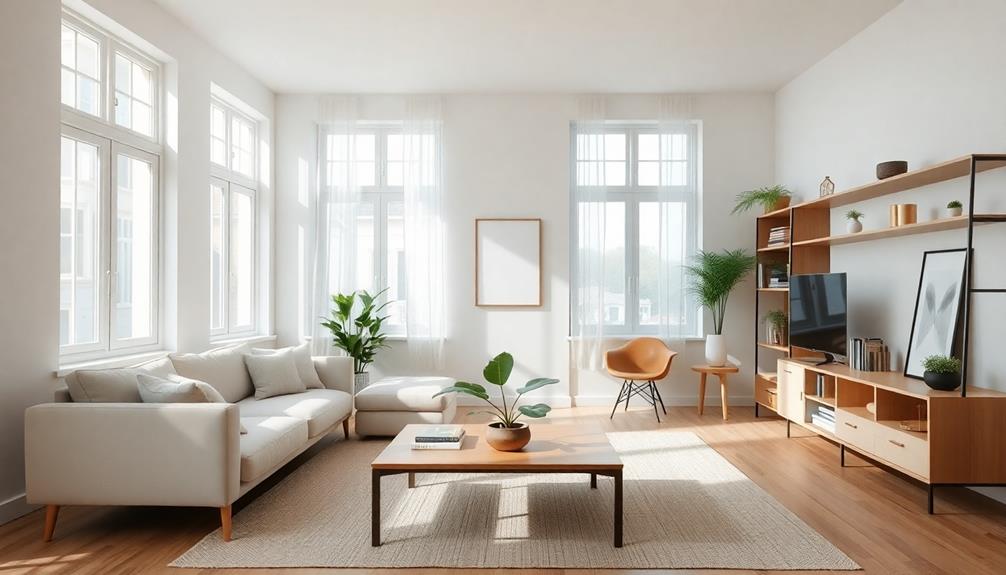
Decluttering isn't just about tidying up; it's a powerful way to transform your home and life. When you embrace decluttering, you reduce stagnant energy in your space, allowing for a smoother flow of Chi energy. Incorporating elements such as Indonesian Decorative Pillows can enhance the vibrancy of your living space while maintaining a clutter-free environment.
This shift can lead to increased feelings of well-being and positivity, as you create an environment that nurtures good Feng Shui. By removing unnecessary items, you symbolize making space for new energy, opportunities, and experiences.
Keeping your living areas and entryways clear not only enhances the welcoming atmosphere but also improves energy circulation throughout your home. You'll notice that the more you clear out clutter, the more mental clarity and focus you'll gain, making it easier to navigate your personal space and life choices.
Regular decluttering promotes a sense of control and satisfaction, impacting your emotional health and overall happiness. When you prioritize a clutter-free environment, you set the stage for a life filled with positive energy and growth.
Importance of the Entryway

Have you ever considered how your entryway impacts the energy of your home? The entryway serves as the primary gateway for life energy, or chi, to enter. Its clarity and organization are essential for promoting positive energy flow.
If you have clutter near the entrance, like shoes and bags, it can block energy flow, leading to stagnant energy and a sense of disorganization. To enhance the welcoming vibe, think about incorporating natural materials like wood or bamboo in your entryway design, as they resonate well with Balinese design characteristics that promote a connection to nature.
To create a welcoming atmosphere, think about utilizing furniture like tables or benches for efficient storage solutions. This helps maintain a clutter-free space that invites positive energy into your home.
Additionally, positioning your entryway furniture to maximize natural light not only brightens the area but also enhances the flow of positive energy.
A well-maintained and aesthetically pleasing entryway sets the tone for your entire home environment. It attracts positive energy, making you and your guests feel welcome as soon as they step inside.
Creating Positive Energy Flow
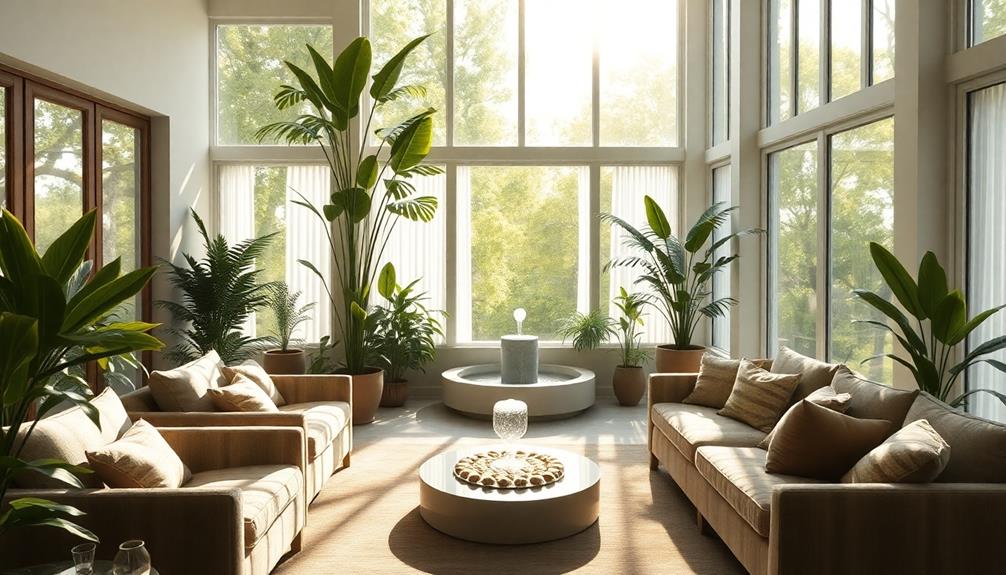
To create a positive energy flow in your home, start by clearing clutter from entryways and living spaces. This aligns with the principles of traditional Indonesian style home decor, which emphasizes harmony and open spaces.
Next, arrange your furniture to promote easy movement and avoid sharp angles that can disrupt the energy.
Clear Clutter Effectively
Amidst the hustle and bustle of daily life, clutter can creep into your home, obstructing the flow of chi energy and creating a sense of heaviness. This stagnation can negatively impact your emotional well-being and productivity.
To foster a vibrant and inviting atmosphere, it's crucial to clear clutter on a regular basis. Incorporating elements like a Face Indonesian Decor Mask can also enhance your space while celebrating cultural craftsmanship, further promoting positive energy.
Here are some effective strategies for decluttering:
- Assess your space use: Regularly evaluate how you utilize each area in your home.
- Dispose of broken or unused items: These represent negative energy, so let them go to invite new opportunities.
- Create designated storage solutions: Organize items to maintain a clutter-free environment that supports your personal Chi.
Aim to clear at least 27 items periodically, as this number symbolizes renewal and transformation in numerology.
By establishing a habit of decluttering, you'll promote energy flowing throughout your home. Remember, a tidy space not only enhances the aesthetic appeal but also cultivates a positive environment where you can thrive.
Embrace the practice of decluttering, and watch as your living space transforms into a sanctuary of positive energy.
Optimize Furniture Arrangement
Creating a harmonious flow of energy in your home starts with smart furniture arrangement. To optimize the energy flow in your living room, position your furniture to create clear pathways for movement. This guarantees that energy, or chi, can circulate freely without obstruction. Consider arranging seating in circular or semi-circular formations to encourage conversation and connection, enhancing the social energy in the space.
Here's a simple table to visualize effective furniture arrangement:
| Tip | Description | Benefit |
|---|---|---|
| Clear Pathways | Avoid blocking doorways and windows | Promotes free energy flow |
| Circular Seating | Arrange chairs in a circle or semi-circle | Fosters communication and bonding |
| Multifunctional Furniture | Use furniture that serves multiple purposes | Maximizes space and balance |
Avoid placing furniture directly in line with doors or windows, as this can disrupt the energy flow and create discomfort. Incorporate natural elements like plants and rounded shapes in your furniture to soften the energy and cultivate a harmonious atmosphere. Small changes in your furniture arrangement can greatly enhance the energy in your space.
Enhance Natural Light
How can you transform your home into a vibrant sanctuary? By enhancing natural light, you can greatly boost the positive energy (chi) in your living space. This simple feng shui tip not only elevates your mood but also creates a warm, inviting atmosphere.
Incorporating elements of traditional decor, such as Indonesian decor masks, can further enhance the aesthetic while respecting cultural heritage.
To maximize natural light, consider the following:
- Use sheer window treatments that allow daylight in while preserving privacy.
- Position mirrors to reflect natural light sources, making spaces feel larger and more open.
- Keep windows clean and unobstructed to promote better light quality.
Additionally, opt for light-colored walls and decor to reflect and distribute natural light throughout your home. This approach not only enhances your interior design but also fosters a sense of warmth and comfort.
When your living space is filled with natural light, you'll notice a notable improvement in your overall well-being and liveliness. By implementing these strategies, you're not just improving your aesthetic; you're creating a sanctuary that nurtures positive energy and encourages a harmonious flow throughout your home.
Enhancing Ambiance With Lighting
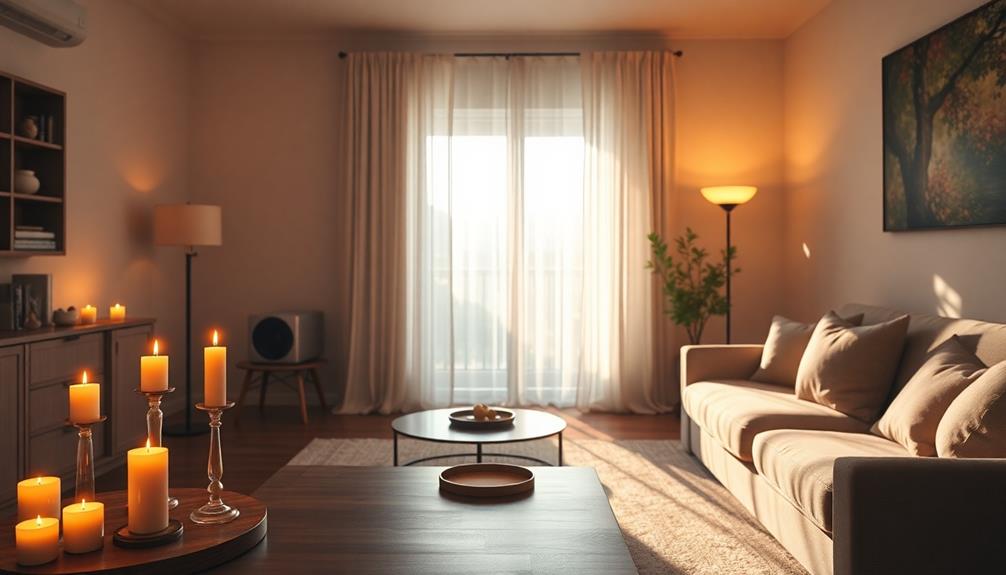
Your home's ambiance can greatly benefit from thoughtful lighting choices. By using multiple indirect light sources like table lamps and wall sconces, you create depth and warmth while reducing harsh shadows. This approach promotes a more inviting atmosphere, enhancing the overall energy flow in your space.
Consider incorporating elements from luxury tropical design aesthetics to further elevate your home's vibe, blending modern luxury with natural elements.
Maintaining a consistent color temperature for your light bulbs—ideally between 2700-3000 kelvins—ensures a cohesive ambiance. This subtle consistency enhances comfort, making your home feel more welcoming.
Incorporating dimmers is another fantastic way to achieve adjustable brightness, allowing you to tailor the lighting to suit different moods and activities, ultimately improving your well-being.
Also, think about strategically positioning your light sources. Highlighting focal points and maximizing natural light can remarkably uplift the energy flow in any room.
Sheer window treatments are a perfect addition, as they allow abundant natural light to enter while softening the overall light quality. This combination creates a warm, inviting environment that promotes relaxation and comfort.
Personalizing Your Space

Personalizing your space is essential for cultivating an environment that truly reflects who you are. When you surround yourself with meaningful items, like personal photographs or heirlooms, you enhance the emotional connection to your home, fostering positive energy.
Incorporating elements of tropical contemporary architecture can also create a serene atmosphere that promotes relaxation. Coordinating colors and textures that resonate with your personal style creates visual harmony, contributing to a sense of comfort and belonging.
Consider these ideas to personalize your space:
- Incorporate art that reflects your experiences and aspirations. This can inspire creativity and greatly impact your mood and energy.
- Utilize natural elements, such as plants or wooden decor, to bring tranquility and balance, enhancing the overall atmosphere of your home.
- Rotate decor seasonally to refresh your aesthetic and symbolize new beginnings, aligning your environment with the cyclical nature of life.
Room-Specific Feng Shui Tips
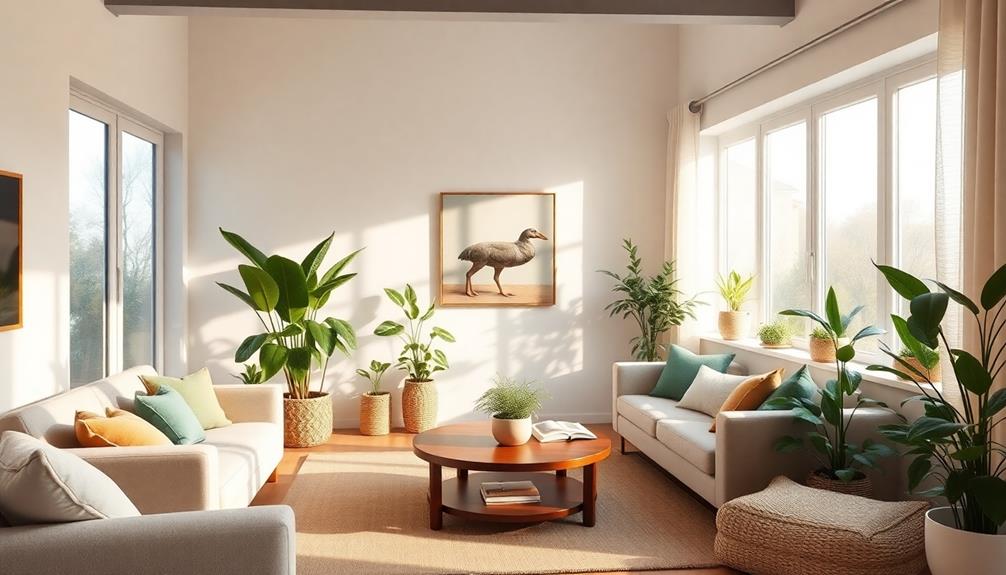
Creating harmonious spaces in each room of your home can greatly enhance the flow of energy and promote well-being.
In your living room, arrange seating to encourage conversation and keep pathways clear; this supports good energy flow. Incorporating elements of modern tropical aesthetics can also enhance the ambiance.
In the bedroom, position your bed so you can see the door, but avoid lining it up directly with it. This setup fosters a sense of security and calm.
In the kitchen, maintain cleanliness and make the stove the focal point—it's a symbol of wealth and nourishment. Confirm the sink is free of dirty dishes to promote health energy.
For your home office, place your desk facing the door to boost productivity and create a supportive environment that encourages focus and clarity.
Lastly, in the bathroom, keep the door closed and use soft lighting along with plants to improve air quality and promote tranquility.
These simple feng shui adjustments in each room help you see and feel a clear difference in the overall energy of your home. By implementing these room-specific tips, you can create spaces that not only look good but also resonate with positive energy.
Frequently Asked Questions
How to Bring Positive Energy Into Your Home Feng Shui?
To bring positive energy into your home, clear clutter, incorporate natural elements, use multiple light sources, position furniture for easy movement, and regularly refresh your space. These actions enhance tranquility and promote a welcoming atmosphere.
How to Increase Yang Energy in House Feng Shui?
To increase Yang energy in your house, let in natural light, use vibrant colors, and incorporate mirrors. Keep your space organized and choose dynamic furniture shapes to promote movement and lively energy throughout your home.
What Is the Energy Source of Feng Shui?
In Feng Shui, the energy source is called "chi." It's the essential life force flowing through all things, influencing your well-being. Balancing chi enhances harmony, creating a positive and vibrant space for you to thrive.
What Is Bad Feng Shui for a House?
You wouldn't believe how bad feng shui could transform your home into a chaotic mess! Clutter, sharp angles, broken items, dark colors, and dirty spaces all invite negativity, suffocating your energy and well-being. Don't let it happen!
Conclusion
By embracing the art of decluttering, you can unfasten a transformative energy in your home that rivals the magic of a fresh spring morning. As you revamp your entryway and allow positive energy to flow freely, you'll see how simple changes, like thoughtful lighting and personal touches, can breathe new life into your space. Remember, just as a well-tended garden flourishes, your home thrives when you nurture it with intention and care.



























